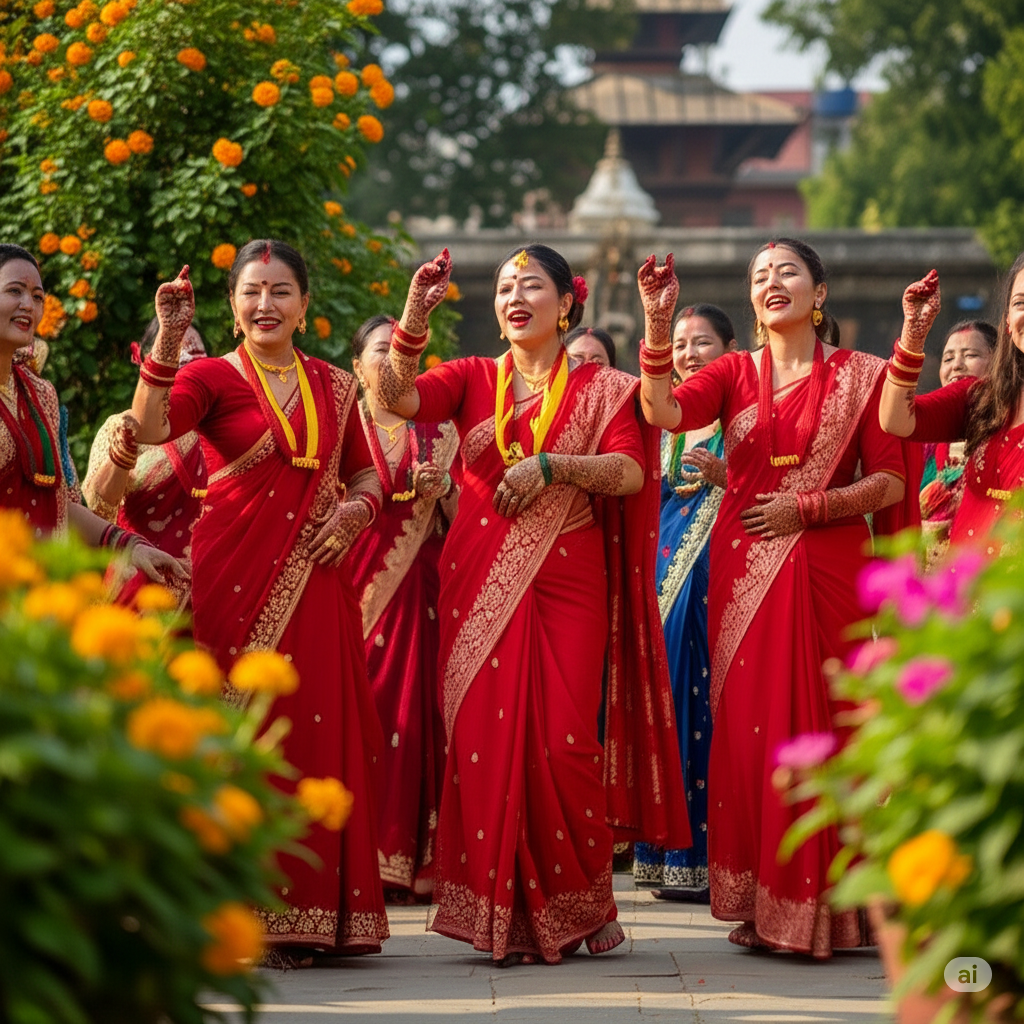A Beginner's Guide to Haritalika Teej Festival: History, Traditions & How to Experience It
Nepal, a land of vibrant culture and deep-rooted traditions, celebrates numerous festivals throughout the year. Among the most colorful and spiritually significant for women is Haritalika Teej. Observed primarily by Hindu women, Teej is a three-day celebration of devotion, marital bliss, and sisterhood, typically falling in the Nepali month of Bhadrapada (late August to early September). In 2025, Teej will be celebrated from August 26th to August 28th.
If you're a visitor to Nepal, or simply curious about this beautiful festival, this guide will provide an in-depth look into its history, key rituals, and respectful ways you can experience it.
The Sacred Roots: History and Significance of Haritalika Teej
The name "Haritalika" is derived from two Sanskrit words: "Harat" meaning "abduction" and "Aalika" meaning "female friend." The festival's origins are steeped in Hindu mythology, particularly the tale of Goddess Parvati and her unwavering devotion to Lord Shiva.
Legend has it that Goddess Parvati, daughter of the Himalayas, deeply desired to marry Lord Shiva. Her father, however, wished for her to marry Lord Vishnu. To prevent this unwanted marriage, Parvati's female friends (Aalika) abducted (Harat) her and took her to a dense forest. There, Parating performed rigorous penance, fasting without food or water for many years to win Shiva's heart. Impressed by her immense dedication, Lord Shiva finally agreed to marry her.
Haritalika Teej commemorates this divine union, symbolizing the strength of a woman's devotion, resolve, and sacrifice to attain a desired husband and ensure his longevity and prosperity. It is a day when married women pray for the well-being and long life of their husbands, and unmarried women pray for a good and loving spouse like Lord Shiva.
The Three Vibrant Days of Teej: Rituals and Traditions
Teej is a captivating three-day celebration, each day holding unique significance:
Day 1: Dar Khane Din (The Feasting Day)
The festival kicks off with "Dar Khane Din," a day of joyous feasting and celebration. Women, adorned in their finest traditional attire—predominantly vibrant red sarees, adorned with bangles, bindis, and intricate mehndi (henna) designs on their hands and feet—gather at their maternal homes or with friends and family.
This day is a grand feast, often prepared by the men of the household, where women are relieved of household chores and can indulge in rich, delicious foods. The "dar" (feast) is meant to nourish them before the rigorous fasting of the following day. Amidst the singing of folk songs, dancing, and merriment, women express their joys, sorrows, and sometimes even social concerns, creating a powerful sense of sisterhood and solidarity that often continues late into the night.
Day 2: The Fasting Day (Hartalika Teej Puja)
This is the main day of the Teej festival. Many women observe a strict "Nirjala Vrat," a fast where they abstain from both food and water for 24 hours, in emulation of Goddess Parvati's penance. Others might observe a partial fast, consuming only fruits and liquids.
Dressed in red and gold, women flock to Shiva temples, particularly the Pashupatinath Temple in Kathmandu, which sees an enormous gathering of devotees. They perform elaborate pujas (worship rituals) dedicated to Lord Shiva and Goddess Parvati, offering flowers, fruits, sweets, sacred items, and lighting oil lamps that are meant to burn throughout the night for good fortune. Songs of devotion fill the air as women pray for marital bliss, the longevity of their husbands, and the well-being of their families.
Day 3: Rishi Panchami (The Purification Day)
The third day, Rishi Panchami, is dedicated to purification and seeking forgiveness for any sins committed, intentionally or unintentionally. Women wake early, take a holy bath (often in a sacred river or pond), and perform a special puja honoring the Saptarishis (seven ancient sages). They use red mud from the roots of the sacred Datiwan bush and its leaves to purify their bodies, symbolically cleansing themselves from any past wrongdoings. After the puja, they break their fast, concluding the three-day observance.
Experiencing Haritalika Teej: What to Expect and How to Participate Respectfully
For visitors to Nepal, Teej offers an incredible glimpse into vibrant Nepali culture and deep spiritual devotion.
- What to Expect:
- Vibrant Colors: The most striking visual is the sea of red sarees everywhere, especially around temples.
- Music and Dance: You'll hear traditional folk songs and see women dancing gracefully in groups, often in open spaces or temple courtyards.
- Devotion: Witness the deep spiritual fervor and dedication at temples, particularly Pashupatinath.
- Community: Feel the strong sense of camaraderie and sisterhood among the women.
- Respectful Participation and Observation:
- Dress Modestly: If visiting temples or public gatherings, wear respectful attire (shoulders and knees covered).
- Ask Before Photographing: Always ask for permission before taking close-up photos of individuals, especially during private rituals.
- Observe from a Distance: At temples, especially Pashupatinath, stick to designated visitor areas and do not disrupt the rituals or the flow of devotees.
- Understand the Fast: Be sensitive to those observing a fast, particularly on the second day. Do not offer food or drink.
- Embrace the Spirit: While you may not participate in the fasting, you can embrace the spirit of joy, community, and devotion by simply observing respectfully and appreciating the cultural significance.
Haritalika Teej is more than just a festival; it's a testament to enduring faith, a celebration of womanhood, and a vibrant expression of Nepali culture. Experiencing it in 2025 offers a unique opportunity to witness profound traditions firsthand and connect with the heart of Nepal.
Please login to leave a comment.


 Rakesh Rajbhat
Rakesh Rajbhat




